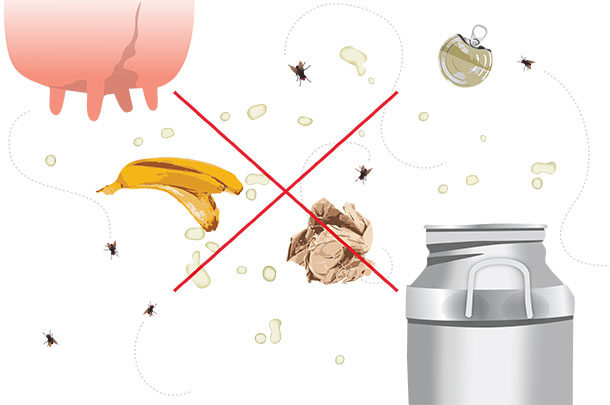The phrase “garbage in, garbage out” was originally used in the field of computer science. Long before it existed, my father had his own saying. He would mention that it would be great to have magic cows: ones that turn bad feed into good health and a lot of milk.
Since that is not realistic, there are steps that can be taken to help manage the herd so cows do have a healthy and productive life. One aspect of this is feeding quality silage.
A component of quality silage includes inoculants. Inoculants are additives applied to improve the ensiling process. They reinforce the natural process of fermentation to provide a longer “shelf life.” Fermentation occurs via bacteria, which are naturally present in most crops. However, some crops do not provide enough bacteria or the right types. Inoculants add extra bacteria to jumpstart the process and improve silage fermentation.
A practical advantage of using bacterial inoculants is their safety. Unlike acids, they are regarded as safe for both people and machinery. Another advantage is their effect on palatability. Research has shown a higher level of voluntary intake when inoculants are used compared to non-treated silage.
To obtain the maximum performance of inoculants, producers should consider the following:
Make it mandatory
Not all silages are made using inoculants, but under some circumstances their use should be mandatory. This will help a producer avoid poor fermentation and other losses associated with adverse conditions, such as moisture content too high or too low as well as areas at risk of clostridium contamination.
Use trusted product
To be trusted, a silage inoculant should have independent, statistically analyzed and published data supporting its use. The more supporting data there is, the more credibility it has.
Two inoculants that contain the same bacteria may not have the same efficacy. A producer should always check that there is independent evidence to back the claims.
Consider the strain
Many bacteria with the same name do not necessarily exhibit the same activity or properties. Different strains are effective with different materials and conditions. A producer should look for a supplier that does genomic mapping with each batch to ensure the correct strain is used.
Use the correct dose
For silage inoculants to be effective, they must be added at a high enough rate to compete against detrimental organisms. This allows them to dominate the ensiling process. An effective silage inoculant will apply a tested number of selected strains of bacteria to ensure a fast, efficient fermentation.
This will reduce dry matter (DM) losses and help preserve more true protein while increasing digestibility. Increased digestibility may help increase an animal’s performance.
A producer should not decrease the recommended rate, as silage is an important ingredient in the cow’s diet. Doing so will decrease the probability of the product working effectively.
Use the correct inoculant
Feeding cows silage with high concentrations of yeasts from secondary fermentation (aerobic spoilage) is often implicated as a cause of poor animal performance. Producers that regularly present secondary fermentation during the feeding phase should invest in silage inoculants that can help prevent this undesirable event and its associated losses.
Unfortunately, the best inoculants available will not prevent spoilage or loss due to poor silage management practices. These tips help ensure silage is of optimal quality:
Cover the silage
Research shows that DM losses in the top 4 feet of uncovered horizontal silos can be in excess of 33 percent compared to 15 percent of normal DM losses – and probably less than that with a more efficient plastic covering. A favorable return on investment for covering may exist by minimizing the amount of surface DM losses.
The use of a high-oxygen barrier film prevents most of the upper layer silage from spoiling. Furthermore, use of a high-oxygen barrier film helps preserve silage while reducing the detrimental effects of yeasts, molds, aerobic and anaerobic spore-formers on nutritional and microbiological quality as it ferments.
Adequate feedout rate
The storage structure must be the correct size so silage removal rates can be maintained. Recommended removal rates include at least 6 inches per day for bunker and piled silos, and 4 to 6 inches per day for upright silos.
Silage should be removed from the bunker and pile faces by shaving the face from top to bottom rather than bottom to top. Lifting creates fracture lines in the stored mass, which allow oxygen to enter and sustain aerobic activity.
Minimize loss during feedout
Aerobic activity occurs while the silo is being filled and at feedout. These are the primary times when DM losses occur.
During the feeding phase, aerobic microbial activity is stimulated by oxygen introduced into the silo. This secondary fermentation produces heat and reduces the palatability and nutrient availability of silage.
Spoilage losses of 1.5 to 4.5 percent DM per day can happen during feedout but may be prevented by using the correct type of inoculant.
Monitor processing
Processing can improve kernel digestibility. During harvest, roller mill settings must be adjusted so all corn kernels are fractured. Processors also break the cobs to increase their consumption and improve silo compaction. This also allows an increased length of cut.
In studies, milk production improved by 0.44 to 4.5 pounds per day with processed corn silage. The decision concerning how long to chop silage must first be based on the type of storage system used. There are practical limits to the lengths of cut used in upright silos due to compaction and consolidation within the silo, as well as compatibility with blowers and unloaders.
Silage inoculants are not capable of turning a bad ensiled material into good feed, but it can make good material a better ingredient in the cow’s diet. It can help make silage fermentation more efficient, thereby preserving more nutrients and dry matter. A producer’s expertise and good silage management, combined with high-quality inoculants, can help achieve performance goals.
There may not be magic cows, but there are steps that can help get the most out of quality silage.






